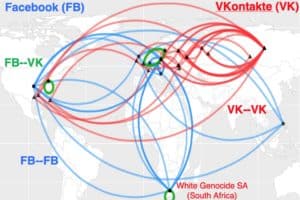Novel Mapping Model Tracks How Hate Spreads and Adapts Online
GWToday, August 21, 2019
Online hate thrives globally through self-organized, scalable clusters that interconnect to form resilient networks spread across multiple social media platforms, countries and languages, according to new research published Wednesday in Nature.
George Washington University researchers developed a mapping model, the first of its kind, to track how these online hate clusters thrive. They believe it could help social media platforms and law enforcement in the battle against hate online.
Through social media, individuals are able to connect with other like-minded people in a just a few clicks. Clusters of those with common interests form readily and easily. Recently, online hate ideologies and extremist narratives have been linked to a surge in crimes around the world. To thwart this, researchers led by Neil Johnson, a physics professor in the Columbian College of Arts and Sciences, set out to better understand how online hate evolves and if it can be stopped.

To understand how hate evolves online, a researcher team led by CCAS Professor Neil Johnson began mapping how clusters interconnect to spread narratives and attract new recruits.
“Hate destroys lives, not only as we’ve seen in El Paso, Orlando and New Zealand, but psychologically through online bullying and rhetoric,” Dr. Johnson said. “We set out to get to the bottom of online hate by looking at why it is so resilient and how it can be better tackled. Instead of love being in the air, we found hate is in the ether.”
To understand how hate evolves online, the research team began by mapping how clusters interconnect to spread narratives and attract new recruits.
Focusing on social media platforms Facebook and its central European counterpart, VKontakte, the researchers started with a given hate cluster and looked outward to find a second one that was strongly connected to the original. They discovered that hate crosses boundaries of specific internet platforms including Instagram, Snapchat and WhatsApp. It also crosses languages and geographic location in the United States, South Africa and parts of Europe.
The researchers saw clusters creating new adaptation strategies in order to regroup on other platforms or re-enter a platform after being banned. For example, clusters can migrate and reform on other platforms or use different languages to avoid detection. This allows the cluster to quickly bring back thousands of supporters to a platform where they have been banned and highlights the need for cross-platform cooperation to limit online hate groups.
“The analogy is no matter how much weed killer you place in a yard, the problem will come back, potentially more aggressively. In the online world, all yards in the neighborhood are interconnected in a highly complex way — almost like wormholes. This is why individual social media platforms like Facebook need new analysis such as ours to figure out new approaches to push them ahead of the curve,” Dr. Johnson said.
The team, which included researchers at the University of Miami, used insights from its online hate mapping to develop four intervention strategies that social media platforms could immediately implement based on situational circumstances:
- Reduce the power and number of large clusters by banning the smaller clusters that feed into them.
- Attack the Achilles’ heel of online hate groups by randomly banning a small fraction of individual users in order to make the global cluster network fall apart.
- Pit large clusters against each other by helping anti-hate clusters find and engage directly with hate clusters.
- Set up intermediary clusters that engage hate groups to help bring out the differences in ideologies between them and make them begin to question their stance.
The researchers noted each of their strategies can be adopted on a global scale and simultaneously across all platforms without having to share the sensitive information of individual users or commercial secrets, which has been a stumbling block before.
Using this map and its mathematical modeling as a foundation, Dr. Johnson and his team are developing software that could help regulators and enforcement agencies implement new interventions.
Dr. Johnson is affiliated with the GW Institute for Data, Democracy, and Politics, which fights the rise of distorted and misleading information online, working to educate national policymakers and journalists on strategies to grapple with the threat to democracy posed by digital propaganda and deception. This research was supported in part by a grant from the U.S. Air Force.
Earlier this month, Dr. Johnson published a paper in Scientific Reports that quantifies how and when extreme subpopulations emerge in a model society where everyone has the same information and available resources. The goal was to better understand why people want to consume extreme online content.
Dr. Johnson found that the varied ways individuals can interpret common information leads to polarization. People interpret news stories differently based on what is going on in their lives, he said, and these extremes are likely to be enhanced over time because of social media algorithms designed to reduce division. These findings contradict a common perception that polarized media consumption is what creates greater ideological divides and feeds online extremism.
[“All content on gwu.edu, including designs, text, graphics, pictures, video, information, applications, software, music, sound and other files, and their selection and arrangement (the website content), is the property of the university or its licensors with all rights reserved. You may occasionally copy individual items of the website solely for your personal, non-commercial use, provided that you keep all copyright or other proprietary notices intact.”]
[Editor’s Note: The article in Nature is called “Hidden resilience and adaptive dynamics of the global online hate ecology,” and is available here. There is a charge of $8.99.]















